WALLENBERG
ALSO BY KATI MARTON
An American Woman
The Polk Conspiracy: Murder and Cover-Up in the Case of CBS Correspondent George Polk
A Death in Jerusalem: The Assassination by Jewish Extremists of the First Arab/Israeli Peacemaker
WALLENBERG
CENTENNIAL EDITION

The Incredible True
Story of the Man
Who Saved Thousands
of Jews
Kati Marton
With a New Preface by the Author

Copyright 1982,1995, 2011 by Kati
Marton Preface copyright 2011 by Kati Marton
All Rights Reserved. No part of this book may be reproduced in any manner
without the express written consent of the publisher, except in the case of brief
excerpts in critical reviews or articles. All inquiries should be addressed to
Arcade Publishing, 307 West 36th Street, 11th Floor, New York, NY 10018.
Arcade Publishing books may be purchased in bulk at special discounts
for sales promotion, corporate gifts, fund-raising, or educational purposes.
Special editions can also be created to specifications. For details, contact the
Special Sales Department, Arcade Publishing, 307 West 36th Street,
11th Floor, New York, NY 10018 or .
Arcade Publishing is a registered trademark of Skyhorse Publishing, Inc.,
a Delaware corporation.
Visit our website at www.arcadepub.com.
10 9 8 7 6 5 4 3 2 1
Library of Congress Cataloging-in-Publication Data is available on file.
ISBN: 978-1-61145-337-9
Printed in the United States of America
To the memory of my grandparents, for whom
Raoul Wallenberg arrived too late


 uring the six months he spent in Budapest, Raoul Wallenberg evinced qualities one rarely encounters outside fiction. Courage, steadfastness, unselfishnessthe words fall flat perhaps because we so seldom associate them with real, living people. They are the stuff of epic poems, novels and films, not life. Yet Wallenberg is very much a human figure. Under ordinary circumstances he may not have called much attention to himself. He is the kind of man one would easily pass on the street and continue walking.
uring the six months he spent in Budapest, Raoul Wallenberg evinced qualities one rarely encounters outside fiction. Courage, steadfastness, unselfishnessthe words fall flat perhaps because we so seldom associate them with real, living people. They are the stuff of epic poems, novels and films, not life. Yet Wallenberg is very much a human figure. Under ordinary circumstances he may not have called much attention to himself. He is the kind of man one would easily pass on the street and continue walking.
The story of what he accomplished in Budapest needs no embellishment. There are fortunately enough eyewitnesses left to enable us to let his deeds speak for themselves. In fact, the dialogue throughout the narrative is from documented eyewitness accounting of events.
Piecing together Wallenbergs story required extensive travel. During my research I made three trips to his native Sweden. I spent time in Budapest, Vienna, Munich, Brussels, London and New York. In all of those places I found people who had known the man and were willing to talk about this dramatic period in their lives. A trip to Moscow provided only local color, no new information.
To discover what has happened to Wallenberg since January 1945, when the Soviets took him prisoner, is almost too painful to bear. The screaming injustice of his brutalization since Budapest is what enrages one. It makes one wish Wallenberg were a piece of fiction, so one could slam the book shut and go back to life. But he is there all the time to remind one of mans capacity for inhumanity to his fellow-man.
As a Hungarian whose parents lived through the Wallenberg period, I learned, in the process of writing this book, things about my former homeland and its history that I would have been happier not knowing.
I am grateful, first of all, to my mother and father, Ilona and Endre Marton, for bringing this period to life for me. I was aware of their courage during the subsequent liberation of Hungary by the Red Army. I knew the details of their imprisonment by the Communists. That was my childhood. I was not familiar with the hell they lived through under the Nazis. That was, and still is, too agonizing for conversation.
Thanks are also due the Baroness Elisabeth Kemeny for sharing for the first time the story of her special relationship with Raoul Wallenberg, and of how, together, they were able to help the people of Budapest. Aladar Szegedi-Maszak, a member of Regent Horthys Foreign Ministry and Hungarys last ambassador to Washington prior to the Communist takeover, and George Schopflin, professor of Eastern European History at the London School of Economics, were both patient in backgrounding the period. Elizabeth Eppler, librarian of the Institute for Jewish Affairs in London, shared her personal recollections of the Budapest underground movement. Thomas Veres, once Wallenberg s photographer and today a successful New York City commercial photographer, contributed observations about the personality and character of Raoul Wallenberg. So did Mikl6s Kalmar and Stephen Radi in New York, and George Wilhelm in Brussels, all vital players in the larger drama.
The tireless correspondence from Claremont, California, of another Wallenberg associate, Dr. Francis Zold, provided insights into both the man and the times, and deserves the authors deepest thanks. Susan Tabors personal rendering of the death march was invaluable.
Nina Lagergren, Raoul Wallenberg s half-sister, gave generously of her time and made available the family correspondence I have used throughout the book. Elie Wiesel put the Wallenberg story in the larger perspective of the Holocaust and Jewish history. Simon Wiesenthal, in his cluttered office in Vienna, made the Gulag Archipelago seem less unreal but no less repellent. Lena Biorck-Kaplan, head of the American Wallenberg Committee, was a tireless source of information.
Robert D. Loomis, vice president and executive editor of Random House, deserves a special note of appreciation for his encouragement and many helpful suggestions. I am grateful for the early faith shown by Gilbert Kaplan.
K.M.

Contents



 riting this book, my first, literally changed my life. In the course of researching Wallenberg, during an interview with a woman who owed her life to the Swedish diplomat, I discovered my own roots. Wallenberg arrived too late to save your grandparents, Clara Koves told me during a routine interview. That simple statement opened the door to my own hidden history. I had been raised a Roman Catholic in Soviet-controlled Hungary, and led to believe that my grandparents perished in an Allied bombing raid. They were, in fact, Jews who had been swept up in one of
riting this book, my first, literally changed my life. In the course of researching Wallenberg, during an interview with a woman who owed her life to the Swedish diplomat, I discovered my own roots. Wallenberg arrived too late to save your grandparents, Clara Koves told me during a routine interview. That simple statement opened the door to my own hidden history. I had been raised a Roman Catholic in Soviet-controlled Hungary, and led to believe that my grandparents perished in an Allied bombing raid. They were, in fact, Jews who had been swept up in one of
Next page
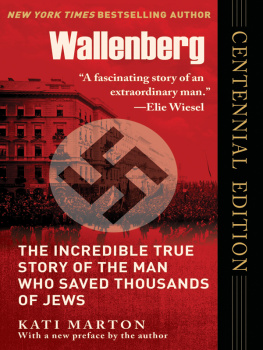



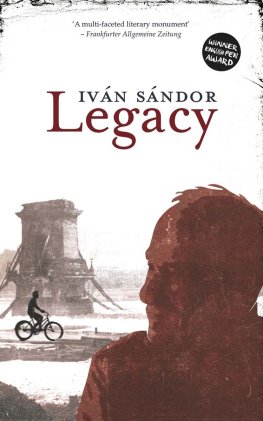
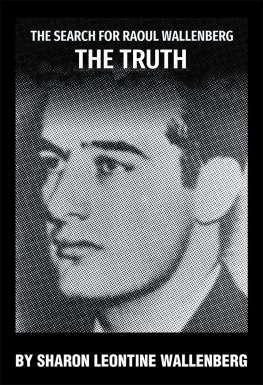
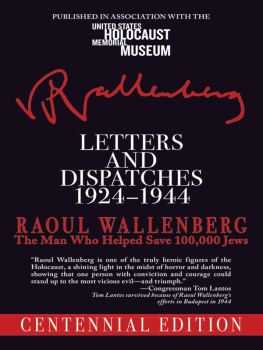
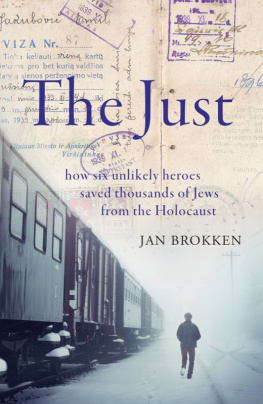


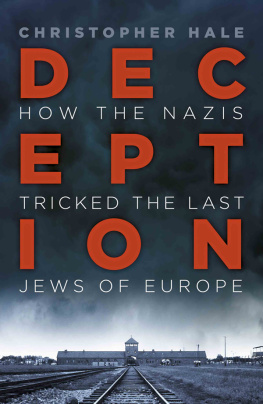

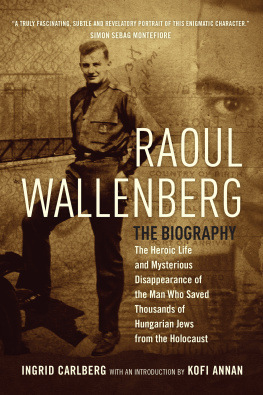
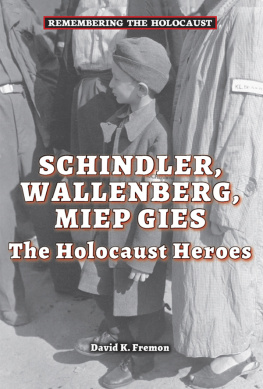
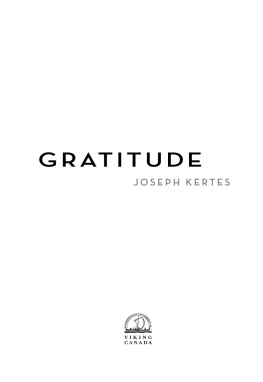



 uring the six months he spent in Budapest, Raoul Wallenberg evinced qualities one rarely encounters outside fiction. Courage, steadfastness, unselfishnessthe words fall flat perhaps because we so seldom associate them with real, living people. They are the stuff of epic poems, novels and films, not life. Yet Wallenberg is very much a human figure. Under ordinary circumstances he may not have called much attention to himself. He is the kind of man one would easily pass on the street and continue walking.
uring the six months he spent in Budapest, Raoul Wallenberg evinced qualities one rarely encounters outside fiction. Courage, steadfastness, unselfishnessthe words fall flat perhaps because we so seldom associate them with real, living people. They are the stuff of epic poems, novels and films, not life. Yet Wallenberg is very much a human figure. Under ordinary circumstances he may not have called much attention to himself. He is the kind of man one would easily pass on the street and continue walking. riting this book, my first, literally changed my life. In the course of researching Wallenberg, during an interview with a woman who owed her life to the Swedish diplomat, I discovered my own roots. Wallenberg arrived too late to save your grandparents, Clara Koves told me during a routine interview. That simple statement opened the door to my own hidden history. I had been raised a Roman Catholic in Soviet-controlled Hungary, and led to believe that my grandparents perished in an Allied bombing raid. They were, in fact, Jews who had been swept up in one of
riting this book, my first, literally changed my life. In the course of researching Wallenberg, during an interview with a woman who owed her life to the Swedish diplomat, I discovered my own roots. Wallenberg arrived too late to save your grandparents, Clara Koves told me during a routine interview. That simple statement opened the door to my own hidden history. I had been raised a Roman Catholic in Soviet-controlled Hungary, and led to believe that my grandparents perished in an Allied bombing raid. They were, in fact, Jews who had been swept up in one of